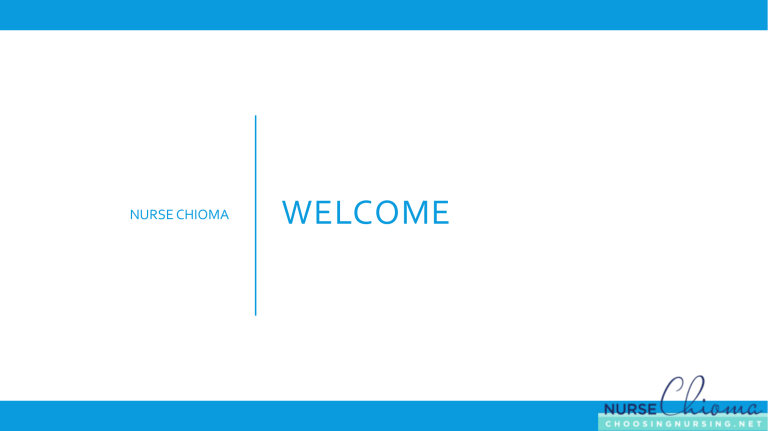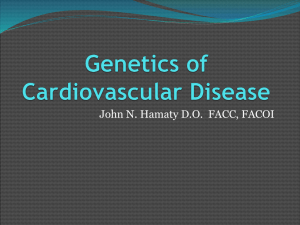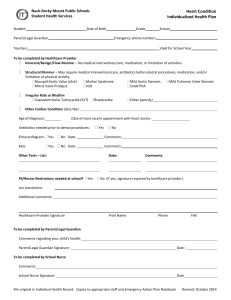
NURSE CHIOMA WELCOME THE 11 BODY SYSTEMS CARDIOVASCULAR/CIRCULATORY SYSTEM THIS SYSTEM Circulates blood around the body via the heart, arteries and veins, delivering oxygen and nutrients to organs and cells and carrying their waste products away. MAJOR ORGANS INVOLVED The heart- The heart is a hollow, muscular organ, which functions as a pump for the movement of blood through the body. The right side of the heart is where deoxygenated blood enters in. The left side of the heart pumps OXYGENATED blood to the entire body. The arteries including coronary arteries and veins are part of this system. THE LAB VALUES INVOLVED Hemoglobin: 13-17 g/dL (men), 12-15 g/dL (women) Hematocrit 40%-52% (men), 36%-47% Glycosylated hemoglobin 4%-6% Mean corpuscular volume (MCV): 80-100 fL Red blood cell distribution width (RDW): 11.5%-14.5% Mean corpuscular hemoglobin (MCH): 0.4-0.5 fmol/cell Mean corpuscular hemoglobin concentration (MCHC): 3035 g/dL Reticulocytes 0.5%-1.5% White blood cells (WBC) 4-10 x 10^9/L Neutrophils: 2-8 x 10^9/L Bands: < 1 x 10^9/L Lymphocytes: 1-4 x 10^9/L Monocytes: 0.2-0.8 x 10^9/L Eosinophils: < 0.5 x 10^9/L Platelets: 150-400 x 10^9/L Prothrombin time: 11-14 sec International normalized ratio (INR): 0.9-1.2 Activated partial thromboplastin time (aPTT): 20-40 sec Fibrinogen: 1.8-4 g/L Bleeding time: 2-9 min CARDIAC ENZYMES Creatine kinase: 25-200 U/L LAB VALUES CONTINUED Creatine kinase MB (CKMB): 0-4 ng/mL Troponin: 0-0.4 ng/mL (you can download a copy of this (Cardio lab values) slides in “resources”) BLOOD FLOW IN THE HEART DEOXYGENATED BLOOD ENTERS THE HEART THROUGH EITHER THE SUPERIOR OR THE INFERIOR VENA CAVA. Then it enters into the atrium where it contracts. Once the atrium contracts the blood flows into ventricles through the tricuspid valve. Once the ventricle is full, the tricuspid value closes and the ventricles contract then the blood begins to flow to through the pulmonic valve to the pulmonic artery PULMONARY CIRCULATION Once the blood flows into the lungs through the pulmonary artery it will become oxygenated blood. Then it will leave the lungs through the pulmonary veins into the left atrium , the left atrium will contract, then blood will travel through the mitral valve into the ventricles. The ventricles will contract then blood will flow through the aortic valve then through the aorta and out to the rest of the body PRESSURE IN THE BLOOD FLOW THIS EXPLAINS HOW THE BLOOD PRESSURE IS EFFECTED IN HIGH BLOOD PRESSURE. Hormones which increase blood pressure include: urotensin II, endothelins, angiotensin II, catecholamines, aldosterone, antidiuretic hormone, glucocorticosteroids, thyroid hormones, growth hormone and leptin. THE HORMONES INVOLVED On the other hand, blood pressure can be decreased by: natriuretic peptides, the calcitonin gene-related peptide (CGRP) family, angiotensin 17, substance P, neurokinin A, ghrelin, Parathyroid hormone-related protein (PTHrP), oxytocin, and, sex hormones. Hormones which when appearing in excess increase the heart rate are: catecholamines, endothelins, glucocorticosteroids, thyroid hormones, leptin and PTHrP. Those which decrease the heart rate include: natriuretic peptides, substance P, neurokinin A, oxytocin, angiotensin 1-7. ILLNESSES/DISEASES Coronary artery disease. Endocarditis Atherosclerosis Shock arteriosclerosis Aortic aneurysm. Stroke. Myocarditis Hypertension pericarditis Heart failure. Cardiomyopathy PERIPHERAL VASCULAR DISEASE TYPES OF HEART DISEASE AORTIC ANEURYSM An aortic aneurysm is an enlargement (dilation) of the aorta to greater than 1.5 times normal size. They usually cause no symptoms except when ruptured. Occasionally, there may be abdominal, back, or leg pain. They are most commonly located in the abdominal aorta, but can also be located in the thoracic aorta. Aortic aneurysms cause weakness in the wall of the aorta and increase the risk of aortic rupture. When rupture occurs, massive internal bleeding results and, unless treated immediately, shock and death can occur. AORTIC ANEURYSM SYMPTOMS INCLUDE: A pulsating feeling near the navel Deep, constant pain in the abdomen or on the side of the abdomen Back pain Signs of rupture include: SUDDEN, INTENSE ABDOMINIAL PAIN DIAPHORESIS DIZZINESS This Photo by Unknown Author is licensed under CC BY-SA LOW BLOOD PRESSURE RISK FACTORS/CAUSES Age. Abdominal aortic aneurysms occur most often in people age 65 and older. Family history. Atherosclerosis. Atherosclerosis — the buildup of fat and other substances that can damage the Tobacco use. Tobacco use is a strong risk lining of a blood vessel — increases THE risk of an factor for the development of an abdominal aneurysm. aortic aneurysm and a higher risk of rupture. Other aneurysms. Male WHITE CAUCASIAN. Men develop High blood pressure abdominal aortic aneurysms much more often than women do. CORONARY HEART DISEASE Coronary artery disease develops when the major blood vessels that supply THE heart with blood, oxygen and nutrients (coronary arteries) become damaged or diseased. Cholesterol-containing deposits (plaque) in THE arteries and inflammation are usually to blame for coronary artery disease. When plaque builds up, they narrow THE coronary arteries, decreasing blood flow to THE heart. Eventually, the decreased blood flow may cause chest pain (angina), shortness of breath, or other coronary artery disease signs and symptoms. A complete blockage can cause a heart attack. HEART FAILURE Heart failure is the inability of the heart to pump sufficient blood to meet the needs of the tissues for oxygen and nutrients. LEFT SIDED HEART FAILURE Pulmonary congestion occurs when the left ventricle cannot effectively pump blood out of the ventricle into the aorta and the systemic circulation. Pulmonary venous blood volume and pressure increase, forcing fluid from the pulmonary capillaries into the pulmonary tissues and alveoli, causing pulmonary interstitial edema and impaired gas exchange. When the right ventricle fails, congestion in the peripheral tissues and the viscera predominates. RIGHT SIDED HEART FAILURE The right side of the heart cannot eject blood and cannot accommodate all the blood that normally returns to it from the venous circulation. Increased venous pressure leads to JVD and increased capillary hydrostatic pressure throughout the venous system. TREATMENT INCLUDES REDUCTION OF SALT INTAKE (LESS THAN 2GM PER DAY) FLUID RESTRICTION TREATMENT SMOKING CESSATION ADMINISTRATION OF DIURETIC MEDICATIONS SUCH AS FUROSEMEIDE (LASIX) High fowler’s positioning CARDIOMYOPATHY Cardiomyopathy is a group of diseases that affect the heart muscle. Symptoms may include shortness of breath, fatigue, or swelling of the legs due to heart failure. CARDIOMYOPATHY Types of cardiomyopathy include hypertrophic cardiomyopathy, dilated cardiomyopathy, restrictive cardiomyopathy, arrhythmogenic right ventricular dysplasia, and takotsubo cardiomyopathy (broken heart syndrome). n hypertrophic cardiomyopathy the heart muscle enlarges and thickens. In dilated cardiomyopathy the ventricles enlarge and weaken. In restrictive cardiomyopathy the ventricle stiffens. Causes are usually related to alcohol use CARDIOMYOPATHY Drugs cocaine or drug use High blood pressure Diabetes mellitus CARDIOMYOPATHY Treatment is essentially the same as treatment of congestive heart failure Medications include: Angiotensin-converting enzyme (ACE) inhibitors Angiotensin II receptor blockers (ARBs) Beta-blockers Aldosterone antagonists Cardiac glycosides Diuretics Nitrates Vasodilators PERICARDITIS Pericarditis is inflammation of the pericardium (the fibrous sac surrounding the heart). Symptoms typically include sudden onset of sharp chest pain. Other symptoms may include fever, weakness, palpitations, and shortness of breath This Photo by Unknown Author is licensed under CC BY-SA CAUSES OF PERICARDITIS USUALLY ARE VIRAL INFECTIONS PERICARDITIS BACTERIAL INFECTIONS CHEST TRAUMA CANCER aortic dissection. PERICARDITIS Treatment for pericarditis is towards reducing inflammation and decreasing pain such as with NSAIDS. Pericardiocentesis, a procedure where a thin needle is inserted through the chest wall into the pericardial sac, may be considered if a large effusion is present that affects heart function. Pericardotomy (cutting a hole in the pericardial sac) or pericardectomy (removing the sac completely) may be needed for recurrent pericarditis that causes scarring within the pericardial sac and prevents the heart from beating properly. HEART SOUNDS Heart sounds are the noises generated by the beating heart and the resultant flow of blood through it. Specifically, the sounds reflect the turbulence created when the heart valves snap shut. HEART SOUNDS The first heart sound, or S1, forms the "lub" of "lub-dub" and is composed of components M1 (mitral valve closure) and T1 (tricuspid valve closure). The second heart sound, or S2, forms the "dub" of "lub-dub" and is composed of components A2 (aortic valve closure) and P2 (pulmonary valve closure). ABNORMAL HEART SOUNDS Heart murmurs are produced as a result of turbulent flow of blood strong enough to produce audible noise. They are usually heard as a whooshing sound. There are different types of heart murmurs. This Photo by Unknown Author is licensed under CC BY-SA HEART MURMURS Regurgitation through the mitral valve is by far the most commonly heard murmur, producing a pansystolic/holosystolic murmur which is sometimes fairly loud to a practiced ear, even though the volume of regurgitant blood flow may be quite small. Yet, though obvious using echocardiography visualization, probably about 20% of cases of mitral regurgitation do not produce an audible murmur. . Stenosis of the aortic valve is typically the next most common heart murmur, a systolic ejection murmur. This is more common in older adults or in those individuals having a two, not a three leaflet aortic valve HEART MURMURS Regurgitation through the aortic valve, if marked, is sometimes audible to a practiced ear with a high quality, especially electronically amplified, stethoscope. Generally, this is a very rarely heard murmur, even though aortic valve regurgitation is not so rare. Aortic regurgitation, though obvious using echocardiography visualization, usually does not produce an audible murmur. Stenosis of the mitral valve, if severe, also rarely produces an audible, low frequency soft rumbling murmur, best recognized by a practiced ear using a high quality, especially electronically amplified, stethoscope. HEART SOUNDS FREE DOWNLOAD Inside the membership site, under “Resources”, you will find a download of different heart sounds to help you become more familiar with different heart sounds that may be covered on THE NCLEX. TETRALOGY OF FALLOT Tetralogy of Fallot (TOF) is a congenital heart defect that is present at birth It is a rare condition caused by a combination of four heart defects. IT cause oxygen-poor blood to flow out of the heart and into the rest of the body It’s missing the pulmonary circulation step! SIGNS AND SYMPTOMS Symptoms include episodes of bluish color to the skin. When affected babies cry or have a bowel movement, they may develop a "tet spell" where they turn very blue, have difficulty breathing, become limp, and occasionally lose consciousness. a heart murmur finger clubbing easy tiring upon breastfeeding RISK FACTORS a mother who uses alcohol A MOTHER WHO has diabetes A MOTHER WHO is over the age of 40 A MOTHER WHO gets rubella during pregnancy. It may also be associated with Down syndrome. THE FOUR DEFECTS a ventricular septal defect, a hole between the two ventricles pulmonary stenosis, narrowing of the exit from the right ventricle right ventricular hypertrophy, enlargement of the right ventricle an overriding aorta, which allows blood from both ventricles to enter the aorta TOF is typically treated by open heart surgery in the first year of life. Timing of surgery depends on the baby's symptoms and size. The procedure involves increasing the size of the pulmonary valve and pulmonary arteries and repairing the ventricular septal defect TREATMENT In babies who are too small a temporary surgery may be done with plans for a second surgery when the baby is bigger. Most people who are affected live to be adults. Long-term problems may include an irregular heart rate and pulmonary regurgitation. QUICK RECAP Reviewed the cardiovascular system and what it is Reviewed the major organs, lab values and hormones involved Different types of heart diseases, signs and symptoms and treatment Heart sounds on the NCLEX exam Tetralogy of Fallot REFERENCES List of systems of the human body https://en.wikipedia.org/wiki/List_of_systems_of_the_human_body How the Heart Works https://www.medicinenet.com/heart_how_the_heart_works/article.htm Lab Values, Normal Adult https://emedicine.medscape.com/article/2172316overview [Hormones and the cardiovascular system] https://www.ncbi.nlm.nih.gov/pubmed/18979453 Tetralogy of Fallot https://en.wikipedia.org/wiki/Tetralogy_of_Fallot THE END




